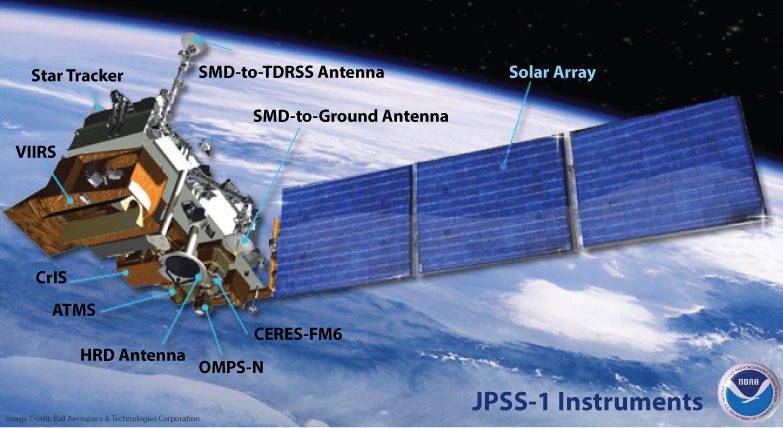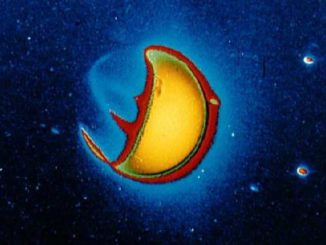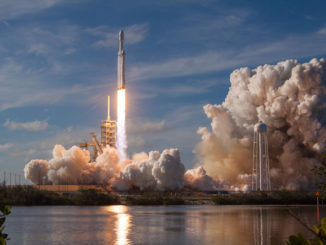
The next-to-last Delta 2 rocket is being stacked at its California launch site to take flight in January to put a civilian weather satellite into polar orbit.
The first stage, interstage, nine strap-on boosters and second stage of the United Launch Alliance rocket are being pieced together over the next two weeks to form the 7920-configured rocket at Vandenberg Air Force Base’s Space Launch Complex 2-West pad.
Lean operations dictated that the on-pad assembly would occur now while workers could break away from their duties on other rockets. They put up the first stage today.
The Delta 2 is protected against the weather by its all-enclosing gantry that cocoons the vehicle entirely.
The stages recently shipped from the United Launch Alliance production factory in Decatur, Alabama to Vandenberg. The solids arrived from Orbital ATK last year.
Launch is targeted for Jan. 20 at 1:47 a.m. local (4:47 a.m. EST; 0947 GMT) carrying the first Joint Polar Satellite System spacecraft.
JPSS is a collaborative project between NASA — which ordered the spacecraft, instruments and launcher — and satellite operator NOAA.

The Ball Aerospace-built satellite will fly in a 512-mile-high orbit, tilted 98.7 degrees to the equator and travel pole-to-pole to survey the entire globe twice per day with five sensor packages.
Data from JPSS 1 will include imagery, atmospheric temperature and humidity profiles, land and ocean surface temperature observations, and measure ozone levels and the reflected solar radiation from the planet.
The information is ingested by numerical computer models to generate weather forecasts and monitor climate trends.
The satellite will be renamed NOAA 20 once operational. It has a 7-year design life.
JPSS 1 is a direct successor in design and mission to the current Suomi NPP weather satellite launched by a Delta 2 in 2011.
File video of Delta 2 stacking. Courtesy of NASA Television
Stacking of the rocket began today when the first stage was lifted vertically with the help of the pad’s mobile service tower and placed atop the launch mount. The 86-foot-long, 8-foot-diameter stage was erected from its transport trailer and the gantry then rolled along its rail tracks to the mount for the rocket to be lowered and secured.
The barrel-like interstage adapter will be attached tomorrow, the nine solids will be hung from July 19 through the 27th, and the second stage will be hoisted into place on July 29 to complete the basic build up of the rocket.
The Delta 2 will be powered away from the pad by its kerosene-fueled Aerojet Rocketdyne RS-27A main engine and six of the solids firing to produce a combined thrust in excess of 750,000 pounds. The remaining three solids ignite a minute into flight.
The second stage will burn its Aerojet Rocketdyne AJ10-118K engine, fueled with storable hypergolic propellants, to reach an initial parking orbit and a further time to deliver the satellite into the prescribed orbit.
The payload is shrouded during atmospheric flight by a 10-foot-diameter composite nose cone.
The Delta 2 will stand 128 feet tall and weigh a half-million pounds at liftoff.
JPSS 1 will launch aboard a Delta 2-7920 rocket. Credit: NASA TV
The venerable Delta 2 has achieved 151 successes in 153 flights since debuting on Valentine’s Day 1989. Its current consecutive success streak stands at 98 flights dating back to May 1997.
JPSS 1 will be the 53rd NASA mission to use the Delta 2.
Delta 2 was the spaceflight workhorse that deployed the Global Positioning System constellation and sustained its capabilities for billions of users around the world, as well as launched such science missions as the Mars rovers Spirit and Opportunity, the Kepler planet finder and the Dawn and MESSENGER probes.
But the Air Force, the anchor tenant of the Delta 2 from its inception in the wake of the shuttle Challenger disaster, retired the military’s use of the rocket in 2009 and shifted GPS launches to the more powerful Atlas 5 and Delta 4 boosters.
With so few payloads in the Delta 2’s weight class, United Launch Alliance opted to phase out the rocket. The manufacturing factory is using up key elements that were stockpiled before production lines were shut down several years ago.
After JPSS 1, the final planned Delta 2 rocket will launch NASA’s ICESat 2 laser altimeter science satellite later in 2017.
Pieces remain in existence to build one additional Delta 2, but it lacks a customer and will likely become a museum piece to pay tribute to the rocket’s remarkable legacy.
See earlier JPSS 1 coverage.
Our Delta archive.



